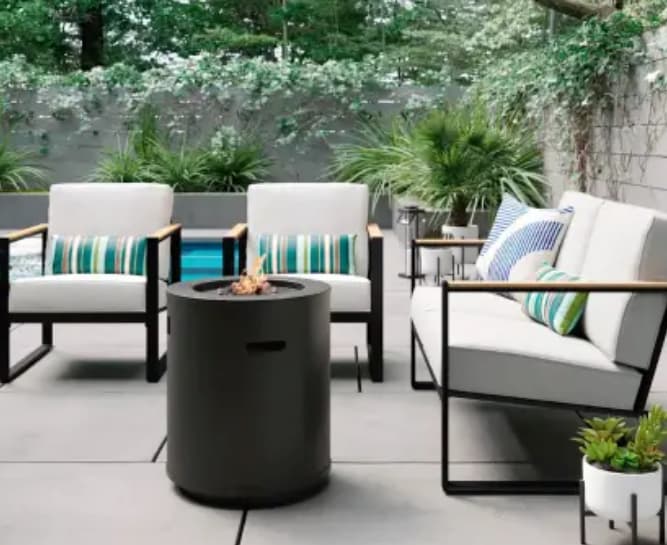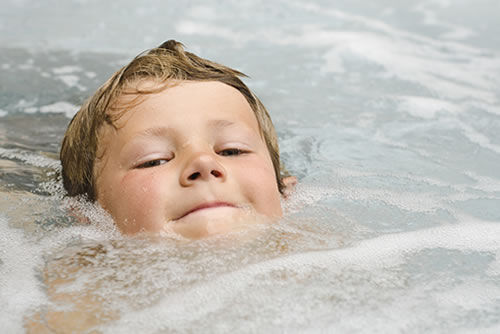Experiencing the warmth of a fire pit on your deck adds comfort and ambiance to outdoor areas. Homeowners frequently ask, “What type of fire pit works well on deck material without ruining it and not causing a safety hazard?”
The best types of fire pits for a deck are ones with a heat shield underneath, as they provide reasonable protection for deck material.
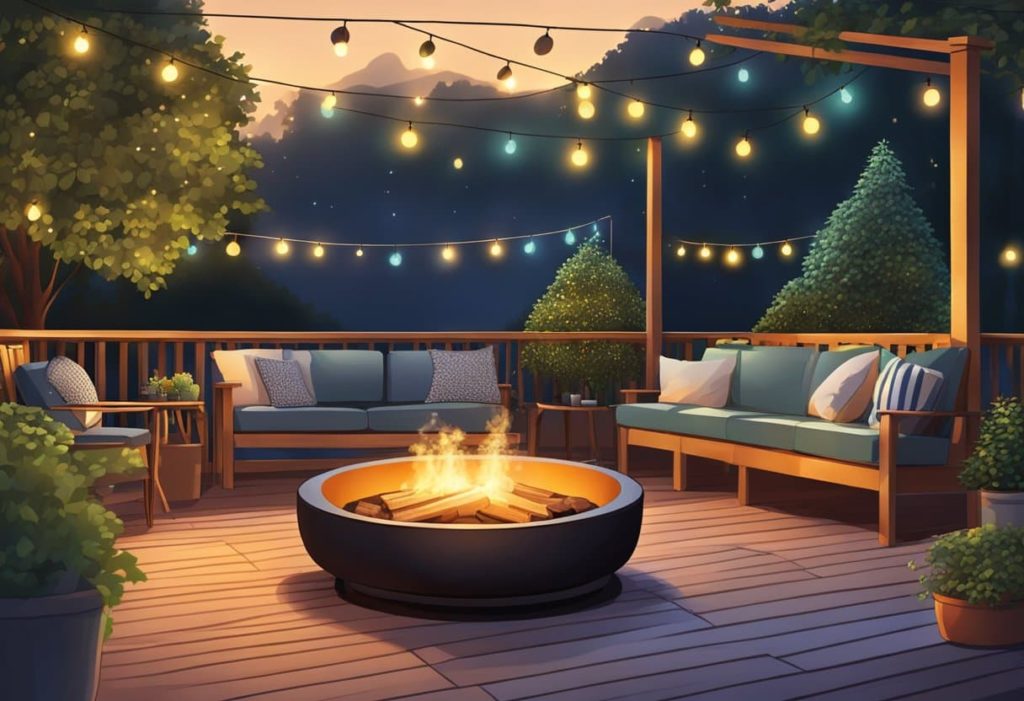
Deck-safe fire pits come in some form from models powered by propane, to wood-burning types with protection. Gas fire pits are probably the safest types on wood decks because they are less prone to throwing sparks, and you could easily have them resting on heat resistant pads. Wood-burning pits should always be elevated above the deck and placed on fire-resistant mats to help eliminate heat transfer.
When selecting a firepit for your deck, you should keep in mind weight, size, fuel types along with safety features. Some raised types of fire pits offer better airflow and less direct heat transfer to the deck boards. In the end, always check your local bylaws as some municipalities have rules regarding open flames on resident decks.
Elevate Your Outdoor Living With the Best Fire Pit for Deck
Choosing the right fire pit can turn an average deck into a important outdoor destination their friend and family can visit any time of the year. The right fire pit gives provides instant warmth for comfort and create a natural focal point for socializing.
Fire pits increase the seasonal use of outdoor living spaces beyond the typical warm season months. Even on chilly spring evenings or brisk fall nights, a quality fire pit can extend your enjoyment into the backyard. I have seen so many families huddle around their fire pit in October while wrapped in blankets making s’mores, as snow falls in the free space between them and the snow-covered ground.
Things to keep in mind when looking at deck-safe fire pits:
- Heat Output: BTUs are heat output and higher numbers mean more heat
- Materials: Weather-resistant options include cast iron, stainless steel or copper
- Size: Decks need a proportionate size
- Safety: Spark screens and secured lids prevent the wood deck from getting too hot
Location is just as, if not more, important. Fire pits must be placed on heat barrier materials and a safe distance from the railings, furniture and overhead structures. Overly many decks are repaired that could have avoided just by proper location.
In our area, local building codes dictate outdoor fires on decks. Many municipalities require safely maintained clearances as well as prohibit certain fuel types by residential lots. Oftentimes in Whitby you must maintain minimum clearances of distance from any area was determined to be an “structure” because of clearance reasons and in that case must have be a minimum 3 metres from the structure in Whitby.
Propane and natural gas models give you the advantage of high temperatures being adjustable flames and no messy ash clean-up. Wood burning models give you the real campfire experience families love; who doesn’t enjoy whining their marshmallows over burning wood, laughing in your friends’ faces while they burn each other’s ugliest marshmallow on the stick? The crackle and smokey smell makes you feel like your family was camping when all you were really doing was being backyard campfires.
Fire pits give you instant atmosphere with swaying flames and gentle crackling sounds. They naturally become the centre of outdoor living space; where you need to be in your moment. Last summer we had a customer say that the fire pit had become their families “no phone zone,” so they just sat together, talked and embraced the moment as a family. At Canadian Home Leisure located in Whitby, our premium selection includes deck-safe models that prioritize safety, style, and durability for your discerning homeowner.
Fire Pit Style Comparison by Fuel Types:
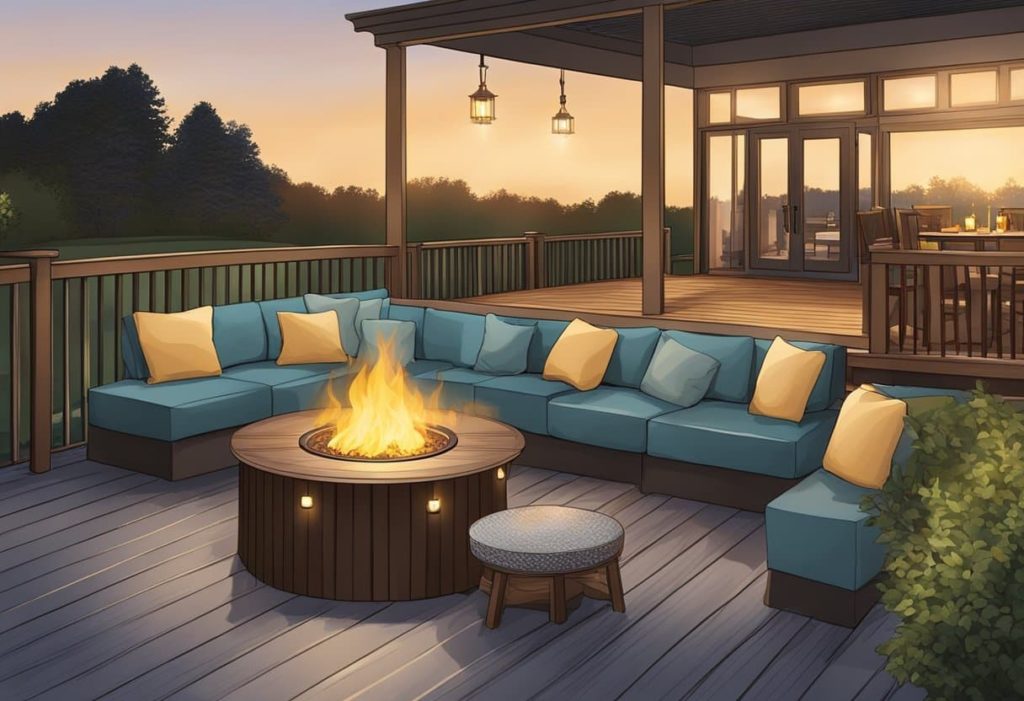
Fire pits come in a range of fuel options with unique advantages for installed on your deck. The fuel type influences everything from heat delivery to maintenance requirements . Let’s take a look at what out there that can handle real Canadian conditions.
Wood-Burning Fire Pits
Wood-burning fire pits offer the true authentic campfire experience complete with the sound of crackling wood and the aroma of smoke. They usually cost less at the outset than gas models but add more maintenance requirements over time—and some people genuinely enjoy the process of tending to their fire.
Pros:
- Best heat output of any category
- No gas tank to fill
- Brings a campfire feeling to the backyard
- Often less expensive in the beginning
Cons:
- Embers and smoke (which can damage decks)
- Requires constant watching
- Need to store dry wood
- More cleanup (and the ash removal process is messy)
If using a wood-burning style, placing a heat shield or a heat barrier on wooden decks is a requirement. Many municipalities also do have specific bylaws regarding the open flames, so follow local regulations to avoid any problems . Getting a visit from the fire department is not the type of excitement you would like at your barbeque.
For use on your deck, the best solutions would come with deep bowls and a mesh spark screen. The deep bowl and spark screen enhance safety by containing small embers that may harm the deck surface. It is regrettable to see a beautiful cedar deck burn spots due to someone not using a spark screen, so forego that error in judgment.
Propane Fire Pits
Propane fire pits are easy to use – you just push a button and can turn it off whenever you want without any messy cleanup, which makes it ideal for your deck and for it to function cleanly. Plus, your neighbors won’t get angry about smoke blowing into their yard.
Key Attributes:
- Easy push-button ignition
- Flame height adjustable
- No smoke or sparks
- All have some portability options
Most propane fire pits will hook up to your standard 20-pound tank (the typical tank), where the tank will go inside the fire pit, or sit nearby. Where the tank goes will affect your design. Table styles conceal the tank inside, while bowl styles may have to have the tank sitting outside.
Although the heat output is 30,000 BTUs to as high as 60,000 BTUs, which is plenty of heat for 4-8 people. The average tank will last between 8 to 12 hours at medium heat. So, about 6-8 evenings depending on the family which is very reasonable in costs.
Many models use decorative fire glass or lava rocks which make the flame very attractive. These also add that even heat distribution while adding visual value to your deck. Fire glass comes in all colors from classic clear to deep hues of blues and greens – and can make your outdoor decor on point.
Natural Gas Fire Pits
Natural gas fire pits are connected directly to your house or yard’s existing gas line for endless fuel. Natural models work great when installed permanently on your deck and convenience as a priority. After installed, you won’t run out at a party again.
Benefits:
- Never runs out of fuel!
- Lower cost log-term over propane.
- No tanks to swap out and refill.
- Consistent quality flame!
Installing a natural model will require gas line extension from a professional. This can bump total set up cost. However, once installed, the operation costs are lower than propane! Most homeowners experience a payback easily within 2-3 years of usual use.
Natural gas gives a clean flame without smoke and ash, making it perfect for covered deck spaces with ventilation. Most natural gas fire pits have weather-resistant burners and ignition systems designed for typical Canadian winter weather.
Permanent fire pits typically have more durable materials like cast aluminum, copper, or stainless steel able to withstand being outdoor all year long. These are no longer portable accessories, and part of your outdoor space with built-in.
Smokeless Fire Pits
Smokeless fire pits do burn wood – but they developed advanced airflow technology that allows it to burn a lot more efficiently and with almost no smoke. These are relatively new in the last few years, but they are very popular on decks, not for any reason (which they are).
These designs use a double-wall design where there is secondary combustion. This means the smoke particles burn away before they leave, having a much cleaner experience. The technology is quite interesting – it is like having a mini furnace on your deck.
Here Are Some Advantages:
- Burns real wood with 80-95% smoke free capability
- Because they are more efficient, you consume less wood
- Lower ash production
- Neighbors complain a lot less
- They smell a lot less of your clothing and furniture
Most smokeless fire pits are portable, and will work as well on a deck, with a heat resistant barrier. They produce huge amounts of heat, without developing concerns for fire hazards of wood burners do. We have had clients go to smokeless fire pits because smoke from their last fire pits drove their neighbors nuts.
The technology does cost a little more, expect to spend more than some basic wood fire pits, potentially a bit less than a high end gas fire pits. For proprietors of decks who enjoy real wood fire and detest smoke, this is the newer option that will work great between the two.
The Best Fire Pits to Use on Your Deck
When it comes to finding the right fire pit for your deck, there are things to consider to keep you safe and to be the right size and style. Wood decks and composite decks have different levels of tolerance to heat, so it is important to select the right one. For example, composite decking can start to soften at a lower temperature than natural wood.
Propane fire pits receive best with regards to safety because you have ultimate control and no sparks to fly, so it is perfect for use on a deck. The Hampton Bay 28-in Gas Fire Pit is 40,000 BTUs of heat and has a protective heat shield for deck surfaces. For this reason, this has become one of our best-selling, firepit tables.
If you are going to select a fire pit for composite deck, find ones with elevated bases or a heat-deflecting shield. Raised decks require distribution of weight, go with models that weigh beneath 30 kg for upper-level or you can risk overly stressing weight on the structure. Once we seen deck joists sag from fire pits that were to heavy and mainly in older construction.
| Type of Fire Pit | Best For | Safety Features |
| Propane | All types of decks | Adjustable, no sparks |
| Natural gas | Permanent location | No fuel to store/firewood |
| Wood burning | With safety precautions | Need a spark screen |
Also, always put down a fire-resistant mat underneath any fire pit in wood deck. This addition can help you from scorching and improve the life of the deck. These mats typically cost between $50-$100, but can save you thousands in repairs.
Regardless of which model you choose, remember you’ll need proper clearance (at least 3m) from railings, furniture, and overhead structures. Local fire codes are not merely guidelines – they are regulations that are meant to protect your family and keep your insurance coverage valid.
What to consider when deciding on a backyard fire pit

When deciding on a backyard fire pit, size matters. Measure your deck before you buy to make sure you’re choosing appropriately sized and safe clearance from railings and furniture. I can’t tell you how many customers have actually had to return fire pits because they made a guess based on eyeballing their measurements rather than actually measuring with a tape measure.
Material is also a consideration, as well as how long the fire pit will last. If you’re looking for aesthetics and longevity, a stainless steel pit will be rust resistant, and will also withstand the harsh Canadian winter. Cast iron pits have great heat retention, but they require more upkeep than others. In order to retain that quality, you’ll need to season it like you would a cast iron frying pan. Clay and stone pits have organic beauty, but could crack with wide swings in temperature.
There are variety of fuel types to choose from:
- Wood fire: Traditional experience of crackling and smoky smell
- Propane: Clean burning, and easy to turn off and on
- Natural gas: Convenient, and requires a professional to install
- Gel fuel: Portable, and minimum smoke, if any.
Portable models are great for small decks or for those who enjoy moving their outdoor setting around. Built-in fire pits provide a permanent focal feature and typically blend well with the existing deck design – your choice comes down to flexibility versus permanent appeal.
The safety features should not be ignored. You want a mat with a sturdy base, a spark screen, and a ventilation system. Having taller sides in a fire pit will keep the embers contained too, which is also a requirement when you have a wood deck. According to the Canadian Association of Fire Chiefs, proper containment reduces fire risk by over 70%.
Adjustable flames options are great for custom experience. Low-smoke options are ideal for smaller spaces, and densly populated neighbourhoods. No wants to be “that neighbour” who smokes everyone out of their backyards.
Weather protection will prolong the length of your fire pit. Many of the quality models have weather protect covers or a weather resistant coating to provide early repairs on rain and/or snow damage. Canadian winters can be rough on outdoor appliances, and proper protection can double your fire pits lifespan.
Materials that Matter
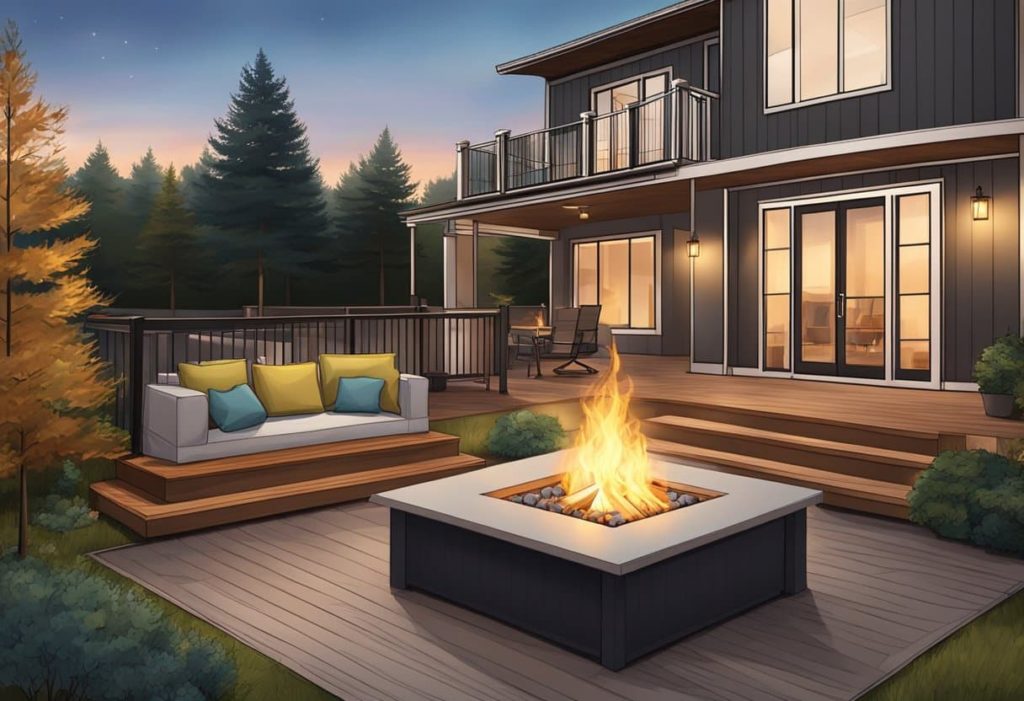
The durability, looks, and safety of your firepit vis-a-vis your deck is heavily reliant on the material. Each of the materials we discuss has their own pros and cons for each intended use and style or close to it. Let’s get into what actually works while they are supposed to in the real world.
Cast Aluminum Fire Pit
If you are seriously considering a firepit for your deck, cast aluminum firepits are typically your best option. Resistant to rust and corrosion, they are the best option for Canadian weather induced rain and snow! After assessing performance in material for five years, the cast aluminum consistently out ranks the other material options.
Cast aluminum firepits are incredibly light; in fact you can move it wherever you want on your deck. Surprisingly tough, I have watched cast aluminum fire pits take direct hail hits that steel could not, and would just suffer denting.
A big check in the cast aluminum firepit column, is heat transfer / conduction. Cast aluminum bars – heat up and transfer the heat evenly across the deck surface itself. Most fire pits do come with a protective cover, which is tightly running, because of the precision assembly.
Most cast aluminum fire pits can run on propane as well; clean burning, so no soot or ash clean up. Most higher end models will include adjustable flame and fun additional features like glass beads for visual and dazzling effect.
Steel Fire Pit
Steel fire pits offer long term durability, and are cost effective. They can withstand high temperature, and highly splinter, and work great for burning firewood or with propane. Thanks to its thermal characteristics, steel performs just as good as a cast aluminum fire pit even at the highest temperatures. Modern steel fire pits often come powder-coated to help prevent rust and prolong life expectancy. If you are using the fire pit on a deck, look for models that employ heat shields underneath that will prevent your deck from getting damaged. Heat shields may keep the deck-surface temperature up to 200 degrees Fahrenheit cooler.
Steel fire tables afford versatility since they provide a large amount of space around the flame. Lots of surface area equates to possible areas for drinks and small plates during outdoor entertainment—no more precariously balancing wine glasses on deck railings!
Many kinds of steel have mesh covers for safety in use and dual-fuel capabilities built in, allowing for options of wood or propane use. The advantage that steel allows is ordinance items still retain the heat and provide warm comfort to your deck space when the fire is out, allowing for an extension of hours of outdoor time.
Stone or Concrete
Stone or concrete fire pits can also be very dramatic statements when presented from a deck. They present as very substantial structure. Stone and concrete materials are designed to withstand extreme temperatures, and heat fluctuations over time, not to degrade—this is the way to create fire for thousands of years.
Despite being heavy-duty, manufacturers also have lightweight concrete that is designed especially for use on a deck, which provides the stone appearance but does not exceed a weight per square foot minimum on your structure to not exceed stress limits of your deck.
Stone fire pits also inherently retain heat extremely well too, as they continue radiating heat hours after the fire is extinguished, perfect for chilly Canadian evenings when you would like to extend outdoor entertaining as long as possible.
Most stone models have propane systems with tank storage that is hidden so that it burns clean (to the environment) and comfortable for people. Keep an eye out for models with ventilation, heat-resistant base system for protecting your deck surface. The blend of natural materials with modern conveniences means you get the best of both worlds.
Copper or Cast Iron.
Copper fire pits gain stunning patinas over time; the older they get, the better looking they become. Their unique aesthetic adds a level of luxury to any deck—they are a conversation piece even before you light the fire!
Cast iron options have the best heat radiation of any fire pit material, making them perfect for warming smaller areas. Both contain and radiate heat well, needing less wood or propane to keep comfortable temperatures.
Special maintenance can prevent rust on cast iron, while copper naturally resists corrosion. Most units include decorative cut-outs that turn the flames into a light performance once they times through—so you can consider it as functional art on your deck.
They work harmoniously with media such as firewood and fire glass media. Their classic aesthetic work with every porch style from rustic to modern. We have installed copper fire pits as the focus of complete deck renovations.
Safety Features Worth the Investment
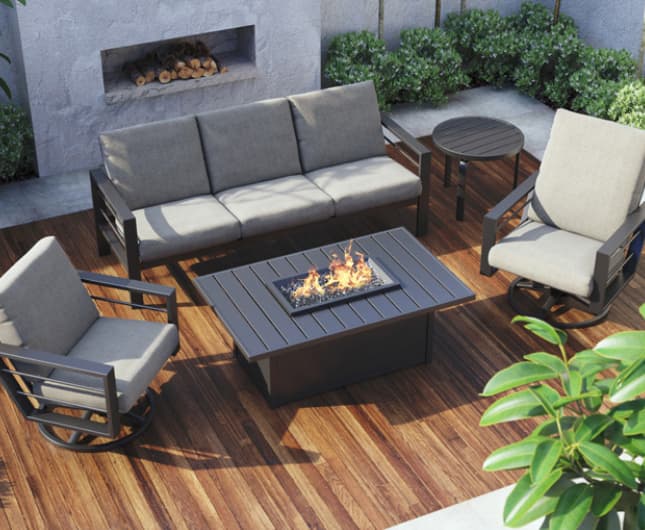
Safety when purchasing a fire pit for your deck should be your number one consideration. Some safety features come at an expense, but trust me, fire department fees are more than good safety features.
The uses a spark guard or screen to keep embers from leaving the fire pit. These spark mesh cover permits the exodus of heat but contains sparks that may vapidly damage your deck or person injury. Quality spark screens resist extreme temperatures without warp or developing holes.
Propane and natural gas models have auto close shut-off valves. If they ignite the flame will purge itself out before gas build-up can occur. Top of the line units may have wind-guards that protect the flame from being extinguished in the first place.
Heat deflection base and panels represent the areas of shields between your fire pit and deck. Heat transfer can warp or ignite combustible materials composite or wood in your decking. Reasonable protective heat shields are a good investment, and can certainly pay for itself by preempting a deck repair cost.
Most fire pits will sustain flame heights above a minimum of 30cm from the deck. The higher the flame height above the deck, the safer it is. If you can get a fire pit with 45cm or higher flame height it will be better! We have found that a minimum of 45cm of safety distance is safe without degrading the warming value of any fire-pit.
Stainless steel or cast iron is a very durable and weather resistant material that is great for durability and safety, it won’t bend, or corrode, and keep structural integrity from the different temperatures associated with the season. Cheap materials will definitely cause weak points some time after winter usage!
As always check local bylaws before installation. There are bylaws in many Whitby neighbourhoods regarding outdoor flames when placed on decks or patios required fire pit sizes or permits for permanent use.
That label; CSA or ULC certification could signify that the fire pit conforms to Canadian safety codes and is a good thing to look for when evaluating fire pit units. These are not just bump-ups they are testing for safety and verification.
Safety tip-over protection safety devices turn the fire pit unit off when unstable, if you have kids or pets this is an important feature. With these sensors, they can help avoid accidents that could ruin a great night.
Accessories that Make the Experience

When you have a fire pit on your deck, it really is amazing what accessories can do to elevate your experience. They add to the functionality, and your outdoor entertaining area suddenly becomes a cozy getaway even better than an expensive resort!
Fire glass brings beautiful visual designs to your fire pit. Fire glass reflects light, creating an astounding effect, bringing a modern touch to your traditional flames. Fire glass is available in many colors, any color that suits your deck style; we have seen ocean blue glass reminiscent of Caribbean islands, to adventure amber which acts like a sunset.
A protective cover is a must-have for Canadian weather. A good cover will protect a fire pit from rain, snow, and debris and will last a long time. Good covers provide vents which prevents moisture from accumulating inside while keeping the elements out.
Grill grates can convert your decorative fire pit to a useful cooking surface. This grill can produce a great spontaneous cookout. It can be used for most fire pits, including a solo stove. Nothing beats grilling burgers with natural flames and good friends.
Tabletop attachments allow you to create a table surface for your fire pit when it is not lit. Installation is simple and allows you to use your fire pit for two purposes, both as a heat source and outdoor table – maximize the amount of usable space on your deck! Here are essential items to consider when buying a fire pit for deck use:
- Spark screen for safety
- Wood grabber for easy fuel handling
- Heat resistant gloves
- Seating (Adirondack chairs are great)
- Cushions that can withstand the weather
- String lights or solar lanterns
Placing patio furniture around a fire pit creates a natural gathering place. Think of putting patio furniture in a semi-circle that is facing the fire to facilitate conversation while keeping things safe. Circular seating is a natural way in which people come together.
Wood holders will help you organize and keep your firewood dry and add rustic appeal to your deck. Stainless steel wood holders won’t weather and will go with most fire pits. Always be sure to have at least 2 days worth of wood to have impromptu fires.
Before you buy: tips for consideration
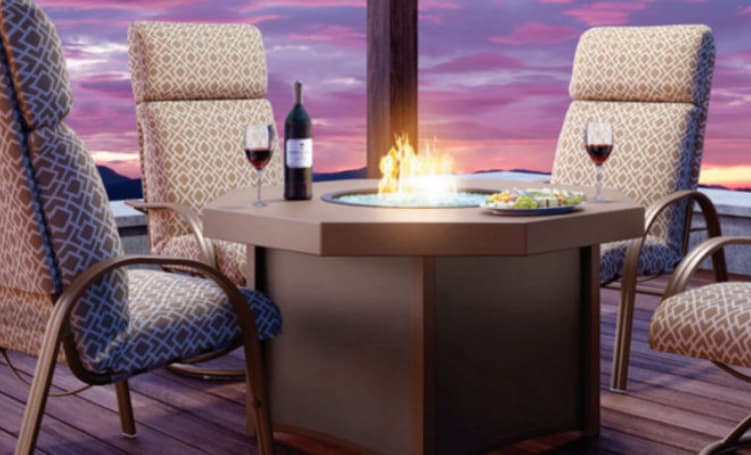
Before you purchase a fire pit for your deck, check your local regulations. Some municipalities in Ontario have restrictions around open flames on wood decks. Permits are required in Whitby for certain types of fire pit installations.
Carefully measure your deck space. Remember to leave a clear 2.0 metres of space around your fire pit for safety and comfort. We have seen many great outdoor spaces fall into unsafe spaces because people don’t think about distance.
Consider where you will keep your fire pit during a Canadian winter. Most excellent fire pits come with covers; however, some need to be stored inside. Consider this prior to purchase not after the first snowfall.
Material Match: Consider materials that match the rest of your deck. Stainless steel and cast aluminum will tolerate Ontario’s four seasons, while looking awesome year after year.
Fuel Option Summary:
- Propane: user friendly, variable flame adjustments, clean burning
- Natural gas: more convenient, no need to refill, professional installation required
- Wood: traditional experience, more maintenance
Size of fire pit should fit: accompany size of your deck and the amount of people you would expect to gather near the fire. A 30 inch fire pit works well for seating 6-8 people while a 24 inch fire pit works for gatherings of 4 or less people.
Be sure to calculate the expense of accessories: protective mats, protective covers, and fuel storage (wood). These important and vital accessories will be between $200-400 of your total cost, and they are critical for operating safely.
Canadian Home Leisure in Whitby carries different models of deck safe fire pits on display. The staff can help you select a model that is perfect for you and your deck. They know local conditions and permitting better than anyone.
Ready to transform your backyard? Lets find the best fire pit for you and your deck. Visit Canadian Home Leisure’s showroom or fill out a contact request for a fire pit specialist who can help you select from a wide variety of fire pits and help you with your outdoor oasis you’ve pictured in your mind.
Frequently Asked Questions
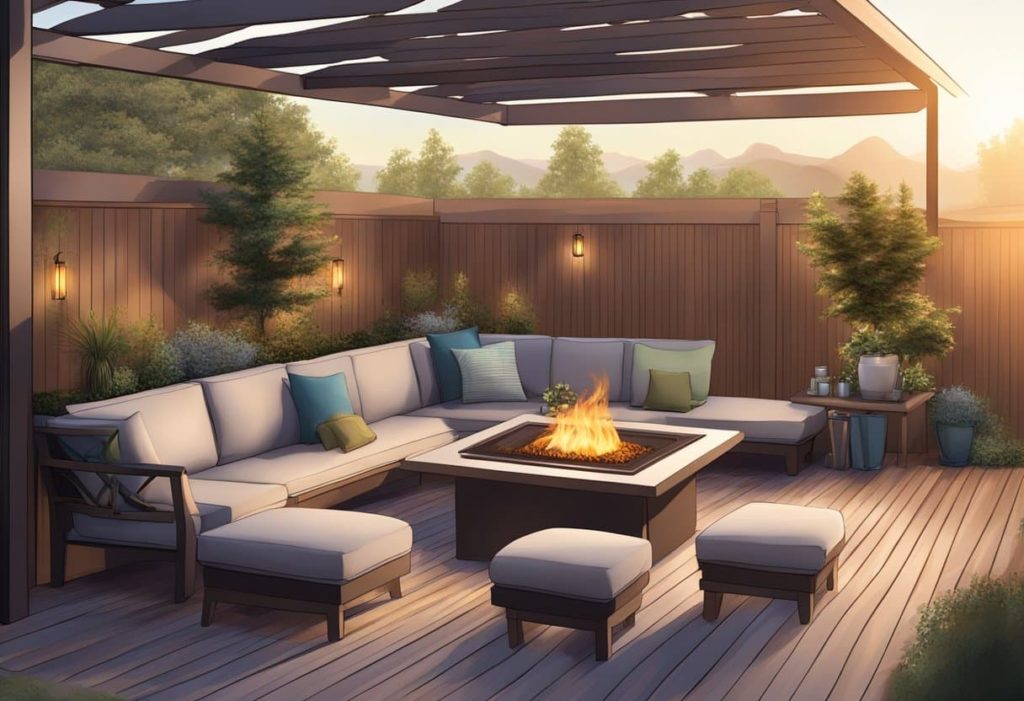
There are some standard fire pit concerns that we hear quite regularly about using fire pits on decks. Let’s essentially address the most commonly asked concerns about safety, features, and fire pit types that get asked often in our showroom.
Which fire pits are deck-safe?
Deck-safe options are fire pits with heat shields or stands. These designs will constantly have lower bottom temperatures and have some heat protection between the heat source and your deck surface. If you’re using a fire pit, always use a fire-resistant pad underneath the unit for added protection (it’s a small thing that prevents most damage).
DIY Fire pits on wood decks are also typically not recommended, unless it was specifically built with heat shielding, and elevation. There are way too many DIY units that we’ve seen cause serious expensive deck damage without proper safety features.
What makes fire pits best for covered patio applications?
For a covered patio, something with least smoke, a fire pit with controllable flames. Features to look for would be adjustable flame control, spark guard, and CSA certification. Covering the emissions safely is not the same; you need to be more careful with the fire pit itself.
Best fire pits for covered patio would be propane or natural gas fire pits, as they do not generate embers or very little smoke. Your patio area needs to be ventilated & height clearance as well, with at least 2.5 meters of overhead clearance is best.
Consider that a fire pit that is lower BTU might be a better fit for the smaller covered patio area, as high-output fire pits could make for very hot, and uncomfortable enclosed spaces.
How Can I enjoy a wood-burning fire pit on the deck safely?
Make sure you position a wood-burning fire pit at least 3 meters from any structures and tree branches. Use a spark screen to reduce angle of attack of embers flying, and also use a heat resistant barrier under the fire pit. Base precautions prevent most issues with a wood deck.
Keep a garden hose, or fire extinguisher nearby. Do not leave fires unattended and always extinguish your fire completely. Most deck fires begin from a non-douse fire or merely “dead” coals.
You may consider using a smokeless wood-burning device to eliminate some embers and ash. These amped-up newer devices burn wood efficiently, all of which is fire with most safety risks.
What are the benefits of smokeless vs. regular fire pits?
Smokeless fire pits significantly reduce smoke outputs meaning your deck and furniture are cleaner. Fuel is burned more efficiently, which means less wood burned, about 30% less wood for the same heat output.
The second combustion design burns hotter, which keeps ash down, and reduces cleaning and maintenance overall, longer-term. Many customers have said they are spending more time using their fire pit instead of maintaining their unit.
Smokeless fire pits in suburban areas are a friendlier solution to neighbours if they are not allowing them to be bombarded with smoke and ash. If you ever had neighbors complain about your smoke, smokeless is an easy answer to that as well, but still have real wood fires.

